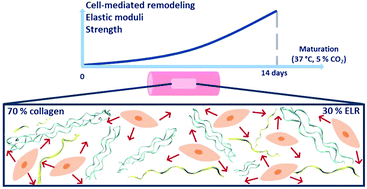Elastin-like recombinamers in collagen-based tubular gels improve cell-mediated remodeling and viscoelastic properties†
Abstract
Natural polymers are commonly used as scaffolds for vascular tissue engineering. The recognized biological properties of this class of materials are often counterbalanced by their low mechanical performance. In this work, recombinant elastin-like polypeptides (or elastin-like recombinamers, ELRs) were mixed with collagen gel and cells to produce cellularized tubular constructs in an attempt to recapitulate the mechanical behavior of the vascular extracellular matrix (ECM). The presence of the elastic protein influenced cell-mediated remodeling evaluated in terms of construct compaction, cell proliferation and ECM (collagen, elastin and fibrillin-1) gene expression. The partial substitution of collagen with ELR and the observed differences in cellular behavior synergistically contributed to the superior viscoelastic properties of the constructs containing 30% ELR and 70% of collagen (in mass). This led to the improvement of 40% in the initial elastic modulus, 50% in the equilibrium elastic modulus, and 37% in the tensile strength at break without compromising the strain at break, when compared to a pure collagen scaffold. Suggestions for future research include modifications in the crosslinking technology, ELR composition, polymer concentration, cell seeding density and dynamic stimulation, which have the potential to further improve the mechanical performance of the constructs towards physiological values.



 Please wait while we load your content...
Please wait while we load your content...